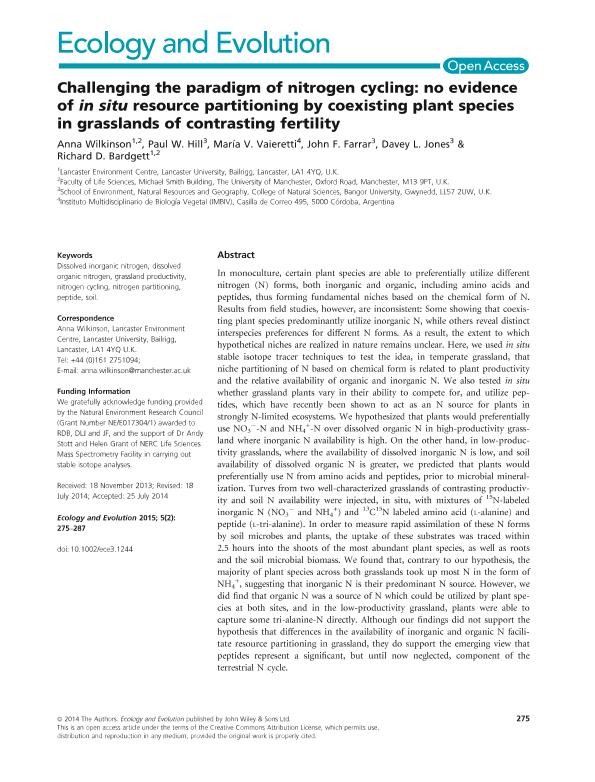Mostrar el registro sencillo del ítem
dc.contributor.author
Wilkinson, Anna
dc.contributor.author
Hill, Paul
dc.contributor.author
Vaieretti, Maria Victoria

dc.contributor.author
Farrar, John
dc.contributor.author
Jones, Davey
dc.contributor.author
Bardgett, Richard
dc.date.available
2017-02-07T15:08:18Z
dc.date.issued
2015-01
dc.identifier.citation
Wilkinson, Anna; Hill, Paul; Vaieretti, Maria Victoria; Farrar, John; Jones, Davey; et al.; Challenging the paradigm of nitrogen cycling: no evidence of in situ resource partitioning by coexisting plant species in grasslands of contrasting fertility; Wiley; Ecology and Evolution; 5; 2; 1-2015; 275-287
dc.identifier.uri
http://hdl.handle.net/11336/12634
dc.description.abstract
In monoculture, certain plant species are able to preferentially utilize different nitrogen (N) forms, both inorganic and organic, including amino acids and peptides, thus forming fundamental niches based on the chemical form of N. Results from field studies, however, are inconsistent: Some showing that coexisting plant species predominantly utilize inorganic N, while others reveal distinct interspecies preferences for different N forms. As a result, the extent to which hypothetical niches are realized in nature remains unclear. Here, we used in situ stable isotope tracer techniques to test the idea, in temperate grassland, that niche partitioning of N based on chemical form is related to plant productivity and the relative availability of organic and inorganic N. We also tested in situ whether grassland plants vary in their ability to compete for, and utilize peptides,which have recently been shown to act as an N source for plants in strongly N-limited ecosystems. We hypothesized that plants would preferentially use NO3--N and NH4+-N over dissolved organic N in high-productivity grassland where inorganic N availability is high. On the other hand, in low-productivity grasslands, where the availability of dissolved inorganic N is low, and soil availability of dissolved organic N is greater, we predicted that plants would preferentially use N from amino acids and peptides, prior to microbial mineralization. Turves from two well-characterized grasslands of contrasting productivity and soil N availability were injected, in situ, with mixtures of 15N-labeled inorganic N (NO3- and NH4+) and 13C15N labeled amino acid (L-alanine) and peptide (L-tri-alanine). In order to measure rapid assimilation of these N forms by soil microbes and plants, the uptake of these substrates was traced within 2.5 hours into the shoots of the most abundant plant species, as well as roots and the soil microbial biomass. We found that, contrary to our hypothesis, the majority of plant species across both grasslands took up most N in the form of NH4+, suggesting that inorganic N is their predominant N source. However, we did find that organic N was a source of N which could be utilized by plant species at both sites, and in the low-productivity grassland, plants were able to capture some tri-alanine-N directly. Although our findings did not support the hypothesis that differences in the availability of inorganic and organic N facilitate resource partitioning in grassland, they do support the emerging view that peptides represent a significant, but until now neglected, component of the terrestrial N cycle.
dc.format
application/pdf
dc.language.iso
eng
dc.publisher
Wiley

dc.rights
info:eu-repo/semantics/openAccess
dc.rights.uri
https://creativecommons.org/licenses/by-nc-sa/2.5/ar/
dc.subject
Dissolved Inorganic Nitrogen
dc.subject
Dissolved Organic Nitrogen
dc.subject
Grassland Productivity
dc.subject
Nitrogen Cycling
dc.subject
Nitrogen Partitioning
dc.subject
Peptide
dc.subject
Soil
dc.subject.classification
Ecología

dc.subject.classification
Ciencias Biológicas

dc.subject.classification
CIENCIAS NATURALES Y EXACTAS

dc.title
Challenging the paradigm of nitrogen cycling: no evidence of in situ resource partitioning by coexisting plant species in grasslands of contrasting fertility
dc.type
info:eu-repo/semantics/article
dc.type
info:ar-repo/semantics/artículo
dc.type
info:eu-repo/semantics/publishedVersion
dc.date.updated
2017-01-31T17:21:54Z
dc.identifier.eissn
2045-7758
dc.journal.volume
5
dc.journal.number
2
dc.journal.pagination
275-287
dc.journal.pais
Reino Unido

dc.description.fil
Fil: Wilkinson, Anna. Lancaster University. Lancaster Environment Centre; Reino Unido. University Of Manchester; Reino Unido
dc.description.fil
Fil: Hill, Paul. Bangor University. College of Natural Sciences; Reino Unido
dc.description.fil
Fil: Vaieretti, Maria Victoria. Consejo Nacional de Investigaciones Científicas y Técnicas. Centro Científico Tecnológico Córdoba. Instituto Multidisciplinario de Biología Vegetal (p); Argentina
dc.description.fil
Fil: Farrar, John. Bangor University. College of Natural Sciences; Reino Unido
dc.description.fil
Fil: Jones, Davey. Bangor University. College of Natural Sciences; Reino Unido
dc.description.fil
Fil: Bardgett, Richard. Lancaster University. Lancaster Environment Centre; Reino Unido. University Of Manchester; Reino Unido
dc.journal.title
Ecology and Evolution
dc.relation.alternativeid
info:eu-repo/semantics/altIdentifier/doi/http://dx.doi.org/10.1002/ece3.1244
dc.relation.alternativeid
info:eu-repo/semantics/altIdentifier/url/http://onlinelibrary.wiley.com/doi/10.1002/ece3.1244/abstract
Archivos asociados
